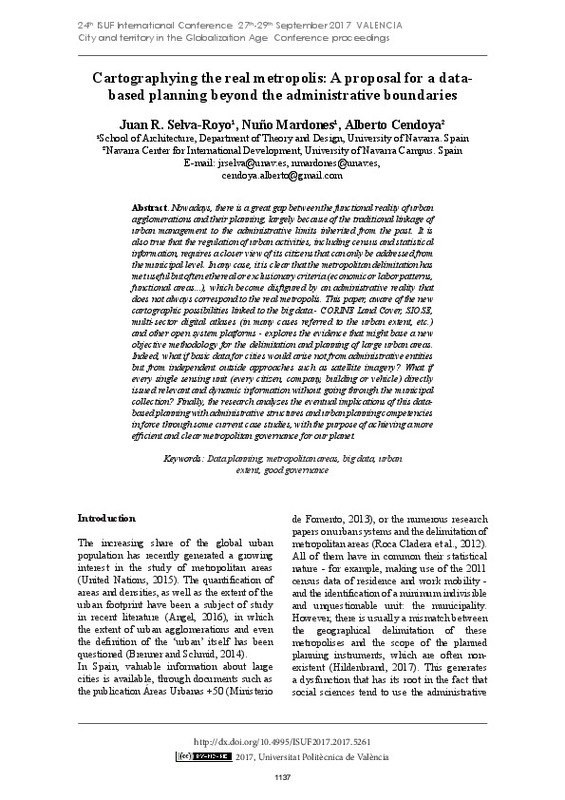JavaScript is disabled for your browser. Some features of this site may not work without it.
Buscar en RiuNet
Listar
Mi cuenta
Estadísticas
Ayuda RiuNet
Admin. UPV
Cartographying the real metropolis: A proposal for a data-based planning beyond the administrative boundaries
Mostrar el registro sencillo del ítem
Ficheros en el ítem
| dc.contributor.author | Selva-Royo, Juan Ramón
|
es_ES |
| dc.contributor.author | Mardones, Nuño
|
es_ES |
| dc.contributor.author | Cendoya, Alberto
|
es_ES |
| dc.coverage.spatial | east=-0.3762881000000107; north=39.4699075; name= Valencia, Espanya | es_ES |
| dc.coverage.spatial | east=-3.7037901999999576; north=40.4167754; name=Madrid, Espanya | es_ES |
| dc.date.accessioned | 2018-12-04T08:09:35Z | |
| dc.date.available | 2018-12-04T08:09:35Z | |
| dc.date.issued | 2018-04-20 | |
| dc.identifier.isbn | 9788490485743 | |
| dc.identifier.uri | http://hdl.handle.net/10251/113446 | |
| dc.description.abstract | [EN] Nowadays, there is a great gap between the functional reality of urban agglomerations and their planning, largely because of the traditional linkage of urban management to the administrative limits inherited from the past. It is also true that the regulation of urban activities, including census and statistical information, requires a closer view of its citizens that can only be addressed from the municipal level. In any case, it is clear that the metropolitan delimitation has met useful but often ethereal or exclusionary criteria (economic or labor patterns, functional areas...), which become disfigured by an administrative reality that does not always correspond to the real metropolis. This paper, aware of the new cartographic possibilities linked to the big data - CORINE Land Cover, SIOSE, multi-sector digital atlases (in many cases referred to the urban extent, etc.) and other open system platforms - explores the evidence that might base a new objective methodology for the delimitation and planning of large urban areas. Indeed, what if basic data for cities would arise not from administrative entities but from independent outside approaches such as satellite imagery? What if every single sensing unit (every citizen, company, building or vehicle) directly issued relevant and dynamic information without going through the municipal collection? Finally, the research analyzes the eventual implications of this data-based planning with administrative structures and urban planning competencies in force through some current case studies, with the purpose of achieving a more efficient and clear metropolitan governance for our planet. | es_ES |
| dc.format.extent | 10 | es_ES |
| dc.language | Inglés | es_ES |
| dc.publisher | Editorial Universitat Politècnica de València | es_ES |
| dc.relation.ispartof | 24th ISUF International Conference. Book of Papers | es_ES |
| dc.rights | Reconocimiento - No comercial - Sin obra derivada (by-nc-nd) | es_ES |
| dc.subject | Data planning | es_ES |
| dc.subject | Metropolitan areas | es_ES |
| dc.subject | Big data | es_ES |
| dc.subject | Urban extent | es_ES |
| dc.subject | Good governance | es_ES |
| dc.title | Cartographying the real metropolis: A proposal for a data-based planning beyond the administrative boundaries | es_ES |
| dc.type | Capítulo de libro | es_ES |
| dc.type | Comunicación en congreso | es_ES |
| dc.identifier.doi | 10.4995/ISUF2017.2017.5261 | |
| dc.rights.accessRights | Abierto | es_ES |
| dc.description.bibliographicCitation | Selva-Royo, JR.; Mardones, N.; Cendoya, A. (2018). Cartographying the real metropolis: A proposal for a data-based planning beyond the administrative boundaries. En 24th ISUF International Conference. Book of Papers. Editorial Universitat Politècnica de València. 1137-1146. https://doi.org/10.4995/ISUF2017.2017.5261 | es_ES |
| dc.description.accrualMethod | OCS | es_ES |
| dc.relation.conferencename | 24th ISUF 2017 - City and Territory in the Globalization Age | es_ES |
| dc.relation.conferencedate | Septiembre 27-29,2017 | es_ES |
| dc.relation.conferenceplace | Valencia, Spain | es_ES |
| dc.relation.publisherversion | http://ocs.editorial.upv.es/index.php/ISUF/ISUF2017/paper/view/5261 | es_ES |
| dc.description.upvformatpinicio | 1137 | es_ES |
| dc.description.upvformatpfin | 1146 | es_ES |
| dc.type.version | info:eu-repo/semantics/publishedVersion | es_ES |
| dc.relation.pasarela | OCS\5261 | es_ES |








